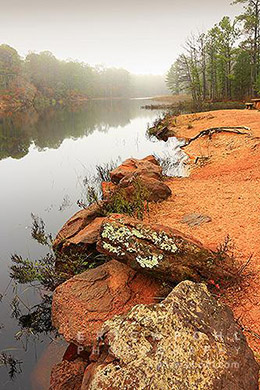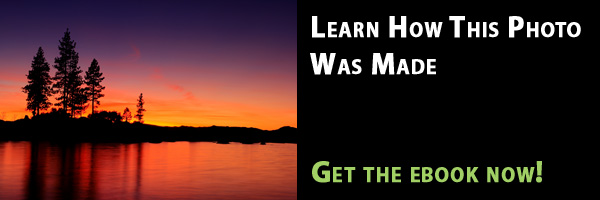
On the downside, without taking a few things into consideration, it can also make a photo dull and washed out. So, here are a few strategies for taking photos in the fog:
Composition Using Depth and Layering
With foggy scenes, emphasizing depth is critical — more so than with any other type of landscape shot.
In fog, the more distance between you and your subject, the less color, texture and contrast the subject will have. Or, depending on the thickness of the fog, nearby subjects may disappear all together.
Without emphasizing depth and only having a single subject, you could end up with a flat or washed out scene. So, to get that foggy enigmatic appeal, I recommend layering your composition — showing foreground, middle ground and background elements, when possible. Objects nearer to you will have more detail, color saturation and contrast. Objects in the middle ground and background will progressively “fade” out as they get further away.
This will emphasize to the viewer that there’s a great big world out there, shrouded in mystery.

In the above image, I used four approximate layers to help convey depth. First, I have the rocks near me as my close foreground. Then, the rest of the cliffside creates a secondary foreground element to emphasize the scale of the cliff. Finally, the river basin makes up my middle ground and the distant hills, lost in the haze, affirm the background.
Overcoming Exposure and Auto-Focus Difficulties
In fog, accumulation of water droplets suspended in the air cause ambient light waves to be uniformly scattered. This results in a soft and evenly diffused light, much like a natural soft box all around you. The downside of this even balance is low contrast and less light.
This type of scene will almost always trick your camera’s internal exposure meter. I recommend shooting in full manual or at least aperture priority mode, where you can control your exposure. You’ll likely need to shoot at least 1/2 stop over what your meter thinks. Another idea is to bracket your exposures in 1/2 stop increments.
A second limitation you sometimes have in fog is lack of autofocus. Depending on the thickness of the fog, this may not be a problem. However, sometimes the low contrast can keep your AF from hitting your intended mark. So if you get the dreaded infinite AF seek, just switch to manual focus and dial it in the old-fashioned way.
Planning for Fog
Fog can happen at any time of year and in all types of landscapes or urban areas. Check your local weather reports to figure out the right time for your next fog adventure.
If you’re planning a foggy photo outing, get an early start. Fog is going to look best in the morning or evening. If fog or heavy haze still lingers around during mid-day, it’s likely to leave you with a washed out, over exposed mess.
Be Flexible!
When shooting in fog, patience and flexibility are mandatory. You might wander around shooting and using your instinct to judge the ever-changing thickness of the fog. Or you might pre-scout a shot, commit to the scene and wait for the fog to bow to your creative will.
Sometimes, you’re not hoping for fog. In the “Old Baldy” shot above, I hiked up to a pre-scouted location hoping for a colorful sunrise. At first light, it turned out to be a foggy morning. So I changed tactics and patience paid off, as the sun briefly peaked through the fog two hours later for a dramatic shot.
Get more great tips in our free weekly newsletter.
 About the Author: Eric Pohl is an Austin-based photographer, travel writer and web designer with a passion for visual communication and a relentless creative energy. From the urban landscape to the natural landscape, his documentary work reveals unique perspectives on the extraordinary environments, places, history, and culture of the world around us. His images and articles can be regularly found in magazines, books and websites covering nature and travel topics.
About the Author: Eric Pohl is an Austin-based photographer, travel writer and web designer with a passion for visual communication and a relentless creative energy. From the urban landscape to the natural landscape, his documentary work reveals unique perspectives on the extraordinary environments, places, history, and culture of the world around us. His images and articles can be regularly found in magazines, books and websites covering nature and travel topics.

Leave a Reply